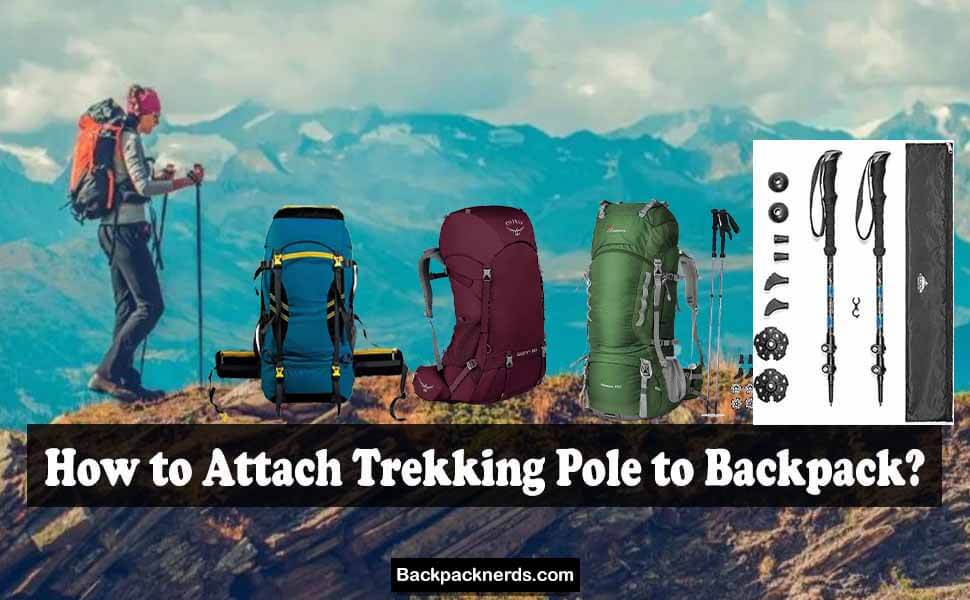If you’re an avid hiker or backpacker, knowing how to attach a trekking pole to your backpack can be a game-changer for your outdoor adventures. Whether you’re traversing rugged terrains or need your hands free during rest stops, securely fastening your trekking poles to your backpack is essential. In this quick guide, we’ll walk you through the simple steps of how to attach trekking pole to backpack to ensure a hassle-free attachment process. Mastering this technique will not only optimize your hiking experience but also keep your trekking poles easily accessible whenever you need them, providing stability and support throughout your journey.
Importance of Attaching Trekking Pole to Backpack
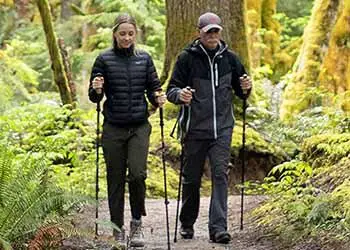
- The Importance of Properly Attaching Trekking Poles: Properly attaching trekking poles to your backpack is crucial for a safe and enjoyable hiking experience. When securely fastened, these poles can provide stability and support, reducing strain on your legs and joints, especially during challenging terrains and steep inclines.
- Benefits of Attaching Trekking Poles to Backpack: Attaching trekking poles to your backpack offers various advantages. It allows you to keep your hands free during rest breaks, enabling you to perform tasks like photography, grabbing a snack, or consulting a map without needing to set the poles down. Additionally, it prevents the hassle of constantly stowing and retrieving them from the backpack.
- Overview of the Attachment Process: The attachment process involves selecting the appropriate attachment points on your backpack, securing the trekking poles to the front or sides of the pack, and ensuring they are properly adjusted for comfort and stability. Different methods, such as using carabiners or straps, can be employed to attach the poles effectively. A well-attached trekking pole can significantly enhance your hiking experience, making it essential to master this process before embarking on your outdoor adventures.
How Do You Attach Trekking Pole to a Backpack
You can check the following video and know how to attach trekking pole to a backpack. And after this video, we have discussed in details. Just check it out.
Read More Articles:
- What to Do With an Old Backpack [7 Things to Do]
- Can I Bring a Backpack to Jury Duty?
- Anatomy of a Backpack [Parts of a Backpack with Images]
- Best Backpacks for Medical School
Selecting the Right Backpack
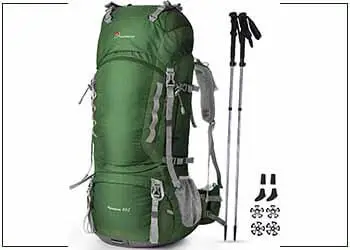
- Consideration of Backpack Design and Features: When choosing a backpack for attaching trekking poles, it’s essential to consider its design and features. Look for a backpack specifically designed for hiking or trekking, as they often come with features like external attachment points and loops that make it easier to secure trekking poles. Additionally, check for compartments and pockets that can accommodate the poles when not in use.
- Weight Distribution and Comfort: The comfort of your backpack is paramount during long hikes. Opt for a backpack that distributes the weight evenly across your back and shoulders, reducing strain and fatigue. A well-padded hip belt and shoulder straps will ensure proper weight distribution, allowing you to hike comfortably even with trekking poles attached.
- Attachment Points and Compatibility with Trekking Poles: Examine the backpack for attachment points or dedicated straps designed to secure trekking poles. Look for adjustable straps or loops that can accommodate various pole sizes. Ensuring compatibility between your backpack and trekking poles will guarantee a secure and stable attachment, preventing any wobbling or potential damage during the hike.
Read More Articles:
- Effective Tips for Preventing Back Pain from Wearing a Backpack
- How to Wear a Backpack Properly
- How to Fit Your Backpack Properly
- Backpack Size Guide
- How Many Books Can You Put In an Empty Backpack
- North Face Recon vs Borealis
Check Some Best Backpacks for Attaching Trekking Pole
Types of Trekking Poles

- Telescopic Trekking Poles: Telescopic trekking poles are adjustable in length, making them versatile for hikers of different heights and ideal for varying terrains. They usually have a collapsible design, allowing for easy storage when not in use. These poles often feature a locking mechanism to secure the desired length, providing stability during the hike.
- Folding Trekking Poles: Folding trekking poles are known for their compact and travel-friendly design. They can be folded into multiple sections, making them easy to carry in a backpack or attach externally. Despite their collapsible nature, folding poles remain sturdy and reliable, offering excellent performance on the trail.
- Lever-Lock vs. Twist-Lock Mechanisms: Trekking poles come with different locking mechanisms to secure their length. Lever-lock mechanisms use levers to tighten and fix the pole’s length, offering quick and effortless adjustments. On the other hand, twist-lock mechanisms require rotating the pole’s segments to set the desired length, providing a secure hold once tightened. Understanding the differences between these mechanisms can help hikers choose the one that best suits their preferences and needs.
Essential Gear for Attaching Trekking Poles
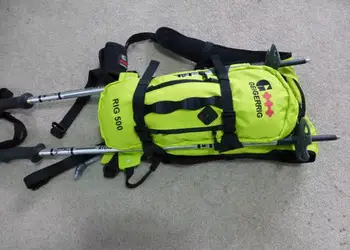
- Trekking Pole Straps and Loops: Trekking poles often come with adjustable straps that wrap around your wrist, preventing accidental drops and allowing you to maintain a relaxed grip while hiking. Some backpacks also have dedicated loops or straps to secure the poles externally or internally.
- Carabiners and Attachment Accessories: Carabiners can be useful for attaching trekking poles to backpacks, especially when the pack lacks specific pole attachment points. They offer a versatile solution, allowing hikers to connect poles to various loops or gear attachment points on the backpack.
- Quick-release Systems and Their Advantages: Some backpacks and trekking pole accessories come with quick-release systems, enabling hikers to detach or reattach the poles swiftly. These systems can be particularly convenient during frequent use or when transitioning between different terrains that require different hiking techniques.
Preparing Trekking Poles for Attachment
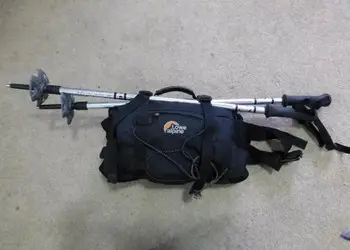
- Adjusting the Poles to the Correct Height: Before attaching the trekking poles to your backpack, ensure they are adjusted to the correct height for your comfort and support. Properly sized poles will allow for efficient arm movement and provide the best stability on the trail.
- Ensuring Poles are clean and dry: Dirt, debris, or moisture on the trekking poles can impact their functionality and attachment. Before securing them to the backpack, clean and dry the poles thoroughly to prevent any issues during the hike.
- Collapsing or Folding Trekking Poles for Compact Storage: For hikers using telescopic or folding poles, collapsing or folding them is essential for easy storage inside the backpack or external attachment. Properly compacted poles also prevent any entanglements with other gear during the hike.
Step-by-Step Attachment Process
- Identifying the Optimal Attachment Points on the Backpack: Look for dedicated attachment points or loops on the backpack designed specifically for securing trekking poles. These attachment points are strategically placed to ensure stability and accessibility while hiking.
- Securing Trekking Poles to the Front of the Backpack: One common method is to attach the trekking poles to the front of the backpack using the available loops or straps. This arrangement allows quick access to the poles during rest stops or when encountering challenging terrain.
- Attaching Trekking Poles to the Sides of the Backpack: Alternatively, hikers may choose to attach the trekking poles to the sides of the backpack. This method is ideal for those who prefer to keep their poles within easy reach without obstructing the front access of the pack.
Step-by-Step Guide: How to Attach Trekking Pole to Backpack
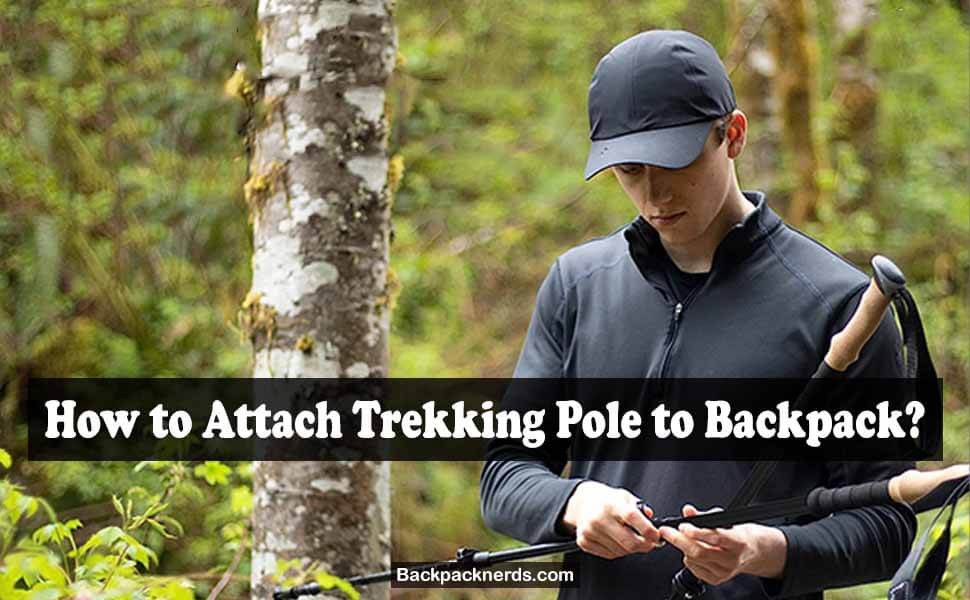
Attaching your trekking poles to your backpack can greatly enhance your hiking experience, providing you with hands-free convenience and easy access to your poles when needed. Follow these simple steps to securely attach your trekking poles to your backpack before hitting the trail:
#Step 1: Choose the Right Backpack
Opt for a hiking backpack that comes with dedicated attachment points or loops for trekking poles.
Ensure the backpack is comfortable and properly fits your body to prevent discomfort during the hike.
#Step 2: Adjust the Trekking Poles
Set your trekking poles to the correct height for your comfort and hiking style.
Make sure the locking mechanisms on telescopic poles are secure.
#Step 3: Locate Attachment Points
Identify the attachment points on your backpack designed for trekking poles. These are typically located on the front or sides of the pack.
#Step 4: Use Pole Straps or Loops
If your backpack has specific pole straps or loops, slide the handles of the trekking poles through them.
Ensure the straps are snug but not too tight to allow for easy retrieval of the poles.
#Step 5: Utilize Carabiners (Optional)
If your backpack lacks dedicated pole straps, you can use carabiners to attach the poles to gear loops or any available attachment points.
Connect the carabiners to the straps or loops on the poles and then attach them to the backpack.
#Step 6: Securely Fasten the Poles
Double-check that the trekking poles are securely attached to the backpack to prevent any accidental detachment during the hike.
#Step 7: Check for Comfort and Stability
Put on the backpack and ensure that the attached trekking poles do not obstruct your movement or cause discomfort.
Adjust the straps and attachments as needed for a secure and comfortable fit.
#Step 8: Test the Balance
Walk around and test the balance of the backpack with the attached trekking poles to ensure they don’t affect your center of gravity negatively.
#Step 9: Practice Retrieval
Practice retrieving the trekking poles from the attachment points to ensure you can do so quickly and effortlessly during the hike.
#Step 10: Inspect Regularly
During breaks or whenever you stop, inspect the trekking pole attachments to ensure they remain secure and haven’t come loose.
#Step 11: Detaching Trekking Poles
When you no longer need the trekking poles or when it’s time to pack up, carefully detach them from the backpack’s attachment points.
If you used carabiners, unclip them and store them in a safe pocket.
By following these step-by-step instructions, you can confidently and securely attach your trekking poles to your backpack, making your hiking adventures more enjoyable and convenient. Remember to always practice proper attachment techniques and regularly check the stability of your trekking pole setup for a safe and rewarding outdoor experience.
Using Carabiners for Quick Attachment
- Utilizing Carabiners with Trekking Pole Straps: If the backpack lacks dedicated attachment points, carabiners can be employed to secure the trekking pole straps to any available loops or gear loops on the pack.
- Attaching Trekking Poles to Backpack Loops with Carabiners: Carabiners offer a versatile solution for connecting trekking poles to external loops or attachment points on the backpack.
- Pros and Cons of Using Carabiners: Understanding the advantages and limitations of using carabiners for trekking pole attachment will help hikers make an informed decision based on their specific needs and backpack features.
Alternative Attachment Methods
- Using Bungee Cords or Elastic Straps: Some hikers opt for bungee cords or elastic straps as an alternative attachment method, providing flexibility and easy adjustment for different pole sizes.
- Building DIY Attachment Solutions: Resourceful hikers may craft their custom attachment solutions using simple materials or repurposed gear, tailored to their backpack and pole preferences.
- Evaluating the Effectiveness of Different Methods: Comparing various attachment methods allows hikers to identify the most efficient and secure option for their individual hiking style and gear.
Adjusting and Securing Trekking Poles

- Ensuring Proper Fit for Comfort and Stability: Properly adjusted trekking poles enhance comfort and stability during hiking, reducing strain on muscles and joints and improving overall balance.
- Double-Checking the Security of Attachments: Before hitting the trail, it’s essential to double-check that the trekking poles are securely attached to the backpack, ensuring they won’t become loose or dislodged during the hike.
- Regular Maintenance and Inspection of Trekking Pole Attachments: Throughout the hike, periodically inspect the trekking pole attachments to ensure they remain secure, and make any necessary adjustments to maintain optimal performance.
Tips for Balancing the Load
- Understanding Weight Distribution with Attached Trekking Poles: Distributing the weight evenly across the backpack and ensuring the poles’ balanced placement allows for comfortable hiking and minimizes strain on the body.
- Achieving Balance on Uneven Terrain: Properly attached trekking poles help hikers maintain stability and balance while traversing uneven terrain, such as rocky or steep surfaces.
- Avoiding Overloading the Backpack with Trekking Poles: Consider the overall weight of the backpack, including attached trekking poles, and avoid overloading it to prevent discomfort and maintain agility on the trail.
Benefits of Hands-Free Trekking Poles
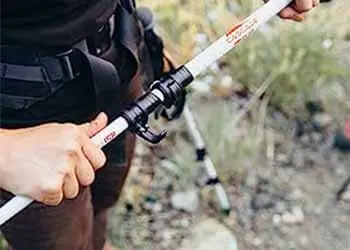
- Enhanced Mobility and Flexibility: By attaching the trekking poles to the backpack, hikers can move freely without being encumbered by carrying the poles in their hands continuously.
- Easy Access to Trekking Poles during Hiking: Having the poles readily available on the backpack allows hikers to quickly deploy them when encountering challenging terrain or when additional support is required.
- Freeing up Hands for Other Tasks: With hands-free trekking poles, hikers can use their hands for various activities such as taking photos, using hiking tools, or grabbing snacks without needing to set the poles down.
Safety Considerations
- Potential Hazards of Improperly Attached Trekking Poles: Incorrectly attached poles can pose safety risks, leading to injuries or damage to the gear. Understanding the importance of secure attachments ensures a safe hiking experience.
- Regularly Checking Attachments during the Hike: Regularly inspecting the trekking pole attachments during the hike ensures they remain stable and functional, preventing potential accidents.
- Adapting Attachments for Different Trail Conditions: Depending on the trail’s difficulty and terrain, hikers may need to adjust the attachment method or pole position to ensure optimum performance and safety.
Detaching Trekking Poles from Backpack
- Quick and Efficient Removal Process: When it’s time to pack up or use the trekking poles actively, hikers should be familiar with the quick and efficient detachment process.
- Ensuring Straps and Carabiners Are Released Properly: Careful handling of straps and carabiners prevents any tangling or damage during detachment.
- Storing Detached Trekking Poles While Hiking: When not using the trekking poles, ensure they are safely stored inside the backpack or externally secured to prevent them from getting lost or damaged.
Troubleshooting and Common Mistakes
- Fixing Loose or Slipping Attachments: If the trekking poles become loose or start slipping during the hike, knowing how to address this issue promptly is crucial for maintaining stability.
- Identifying and Rectifying Attachment Problems: Recognizing and correcting attachment problems can prevent potential mishaps and ensure a smooth hiking experience.
- Learning from Mistakes to Improve Future Hikes: Understanding common mistakes and learning from them allows hikers to enhance their trekking pole attachment techniques and overall outdoor skills.
Best Practices for Carrying Trekking Poles on Backpacks

- Securing Trekking Poles for Easy Access during the Hike: Ensuring the trekking poles are easily accessible on the backpack allows hikers to quickly deploy them whenever needed.
- Evaluating the Backpack Load for Comfort and Efficiency: Maintaining a balanced and well-distributed load on the backpack contributes to a more comfortable and efficient hike, especially with attached trekking poles.
- Practicing the Attachment Process at Home before Heading Out: Before embarking on a long hike, practicing the trekking pole attachment process at home will familiarize hikers with their specific gear setup, minimizing surprises on the trail.
Things to Avoid While Carrying Trekking Poles
Trekking poles are a valuable asset for hikers and backpackers, but their proper handling is crucial to avoid inconveniencing others or causing harm. To be a considerate trekking pole user, steer clear of these actions:
- Avoid waving them around wildly.
- Refrain from letting them dangle from your wrists.
- Never use them to prod people or animals.
- Resist leaning on them excessively while resting.
- Avoid obstructing trails with their placement.
- Never strike people or gear with them.
- Refrain from using them to stake down tents or tarps.
- Don’t use them for hanging food bags or bear bags.
By adhering to these simple precautions, you can protect your trekking poles from damage and ensure the safety and enjoyment of fellow hikers and nature enthusiasts.
Final Words
In conclusion, mastering how to attach trekking poles to your backpack is a valuable skill that can elevate your hiking adventures to new heights of convenience and comfort. By following the simple step-by-step guide, you can ensure a secure attachment, allowing you to hike hands-free and access your trekking poles whenever the need arises. Remember to select a suitable backpack with dedicated attachment points, adjust your trekking poles to the correct height, and fasten them securely to the front or sides of your pack. Whether you choose to use pole straps or carabiners, the key is to strike a balance between stability and ease of access. With this knowledge, you can confidently embark on your outdoor journeys, fully equipped and prepared to tackle any terrain with the added support of your trekking poles.
Image Credit:

